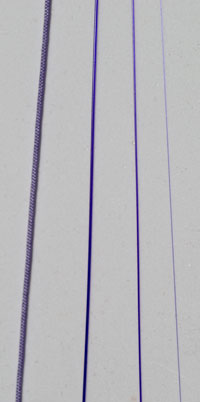Size refers to diameter of the suture strand
- the larger the suture diameter, the relatively stronger it is
- measured in metric units (tenths of a millimeter) or by a numeric scale standardized by USP regulations.
- USP scale runs from 11-0 (smallest) to #7 (largest)
- zeros are written as 2-0 for 00 and 3-0 for 000, etc. for convenience and clarity
- From 0 to 11-0, each extra zero corresponds to a unit decrease in diameter (e.g. 0, 00, 000, etc. until the smallest size of eleven 0s is reached)
- ie.more zeros means smaller (and weaker)
- #1 to #7, are referred to as “number 1” to clearly differentiate them from the metric system
- the selected size and tensile strength should approximate the tissue being sutured. The goal is to select the smallest suture that will support the incision.
- too fine → breaks before tissue heals resulting in dehiscence
- too large → tissue conforms to suture rather than the opposite
- too large → more foreign material in wound causing more tissue reaction and slower wound healing


